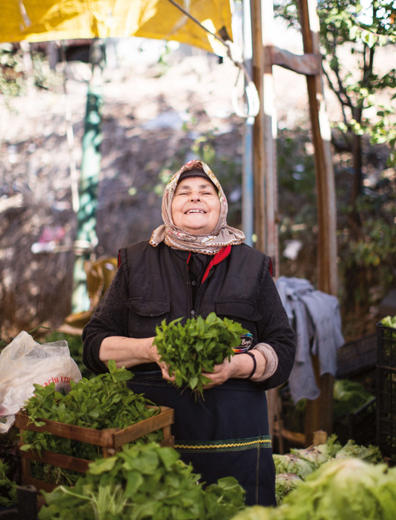
The first time I saw Istanbul was as a student in the mid-1980s. Back then, donkey carts still trundled across the old iron Galata Bridge and the dolmuş (shared taxis; same etymology as the word dolma, or “stuffed”) were hoary 1950s Plymouths and Chevrolets. And from the very first day I was smitten. I couldn’t get enough of the magical skyline with its domes and rocket-like minarets; I kept riding the hulking white public ferries at dusk as the skies flared up cinematically over the sixth-century silhouette of the Hagia Sophia. But mainly I was hooked on the food. With its succulent kebabs and simple grilled fish, its healthful vegetable stews, bright salads, böreks (shaggy savory pastries), and sun-ripened vegetables, Turkish cuisine seemed to me like the last undiscovered frontier of Mediterranean cooking. I got addicted to the tulip-shaped glasses of strong, sweet tea drunk in shady tea gardens. I loved the dollhouse-like baklava shops and the scent of grilled mackerel sandwiches along the docks. I spent my evenings at meyhane, atmospheric dens serving raki (an anisey spirit) and all manner of meze (small plates), from creamy garlicky dips to stuffed mussels. Even the slender cucumbers sold by street vendors as a refresher seemed somehow ambrosial. And the meals often came framed by views so breathtakingly beautiful, I couldn’t shake off the feeling that the city was a mirage.
More than a decade later, as a newly minted food writer, I returned to report a magazine article on Istanbul’s foodscape and had the blessed luck of having Engin Akin as my guide to the city’s clamorous bazaars, smoky kebab joints, and genteel fish restaurants on the Bosphorus shores where white-jacketed waiters ceremoniously mosaicked the table with meze. Though previously we’d met only briefly at a food conference in Greece, Engin tended to me with unflagging zeal—Turkish hospitality personified. Going around with Engin was thrilling, and a little intimidating. A walking textbook on Ottoman food mores and vernacular street snacks, she examined spices like a sultan inspecting troops, haggled fishmongers and butchers into submission, imperiously waved away any morsel of food she considered imperfect. Together we searched for the ultimate lahmacun (wafer-thin, lamb-topped flatbreads baked in a wood-burning oven), the most pistachio-intensive baklava, and the plumpest mantı (thimble-size dumplings) served under a tart cloak of yogurt.
I kept returning to Istanbul again and again, until finally, besotted with the city and inspired by Engin, I ended up buying an apartment there—a little place with a Bosphorus view. Now I own my own set of tulip-shape glasses for sipping tea while gazing at the boat traffic outside my window. Istanbul’s restaurant food is more delicious than ever, but it’s nothing compared to the flavors in people’s homes—especially Engin’s home, where dinner could involve an Ottomanera stuffed melon, an epic lamb shank with burnished, caramelized quince, and homemade halva for dessert.
Over some two decades of friendship, Engin and I have cooked together at many different places. Or rather she’s cooked and I’ve watched—and tried to keep up and take notes. “Turkish cuisine marries palace finesse with rugged nomadic traditions,” Engin will expound while fashioning an addictive börek from thin sheets of yufka pastry and a meat filling sweetened with masses of onions, or while putting a fragrant finishing flourish of mastic on an Ottoman pilaf. On Engin’s boat during an indolent Aegean voyage, instead of the usual boat fare—makarna, or pasta—she’ll concoct a sophisticated warm salad of bulgur studded with walnuts and pomegranate seeds.
At the cooking school Engin operates in her stately ancestral home in the traditional hamlet of Ula, I’ve learned my all-time favorite eggplant preparation: charred over live fire, briefly sautéed in olive oil with sun-dried tomatoes, then presented on a bed of garlicky yogurt with a finish of sizzled brown butter. That, and a majestic clay pot–baked chicken stuffed with spiced rice. At Engin’s Istanbul house, I’ve watched her throw an impromptu meze party for ten on her lush grassy lawn overlooking the Bosphorus. From that bash, I picked up her recipe for dainty herbed köfte (meatballs) laced with pistachios, which I make all the time, and braised fresh pinto beans scented with cinnamon.
Back in New York, craving more “Engin food,” I’ve urged her many times to write a Turkish cookbook in English. Finally, that book is here. It’s the product of Engin’s skills as a cooking teacher, her flair in the kitchen, and her deep love and knowledge of her country’s cuisine, culture, and history. The recipes you’ll find in it are both classic and fresh. As the title suggests, the book is indeed “essential” thanks to primers on Turkey’s garlicky dips, smoky grilled meats, plump stuffed vegetables, earthy meat-and-legume stews, and syrup-drenched pastries. But there are also surprises aplenty. You will be introduced to zeytinyağlı (zey-thin-yah-lih), a wondrous silken veggie confit in which beans or artichokes or leeks are braised for an eternity in olive oil with a secret pinch of sugar that teases out their natural sweetness. You will discover fresh, surprising flavor combinations such as lentils with quince and mint from the town of Bolu, bulgur with chestnuts and tangerines (Engin’s invention), and every iteration of eggplant. And if, like me, you regard cuisine as a window onto culture and history, Engin’s texts on everything from the grand kitchens of the Ottoman palaces to the evolution of Turkish meze rituals will keep you up all night reading. Welcome to the wondrous world of Turkish cuisine.